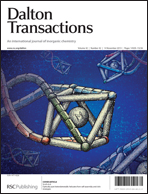A series of ionic zinc–salicylideneimine compounds, [HNEt3][Zn(L)Cl2] (L = salH-4-CN, 1; salCl-4-CN, 2; salBr-4-CN, 3; salOMe-4-CN, 4) and [NEt4][Zn(salH-4-CN)Cl2] (5), have been synthesized and structurally characterized. Compounds 1–5 all display an intense fluorescence band in both solution (methanol, MeOH; acetonitrile, ACN; dimethylsulfoxide, DMSO; dichloromethane, DCM) and solid phases, with a maximum in the region of 515–560 nm and 529–573 nm, respectively. Detailed 1H NMR and optical spectroscopic studies indicate the occurrence of ligand dissociation and recoordination in 1–4 in solution, leading to an equilibrium between the zinc–salicylideneimine complex species, [Zn(L)Cl2]−, and the salicylideneimine free ligand, HL. The tendency of ligand dissociation is related to the solvent, the concentration, and the substitution of the salicylidene ring. The greatest degree of ligand dissociation is observed for 1–4 when dissolved in noncoordinating, less polar DCM solvent, followed by coordinating, high polar DMSO solvent. The least degree of ligand dissociation occurs in solutions of coordinating, moderately polar MeOH and ACN solvents for 1–3 and 4, respectively. Dilute solutions are likely characterized by the high degree of ligand dissociation, whereas the equilibrium shifts in favor of the complex [Zn(L)Cl2]− form at higher concentration. Furthermore, the electron-donating methoxy substitution in the salicylidene ring promotes a high tendency for ligand dissociation, while electron-withdrawing chloro and bromo groups cause the reverse tendency. The 1H NMR spectrum of 5 shows only one set of proton resonances in the aromatic region corresponding to the complex [Zn(salH-4-CN)Cl2]− species, indicating that the lack of ammonium proton would protect the complex form from ligand dissociation.


 Please wait while we load your content...
Please wait while we load your content...